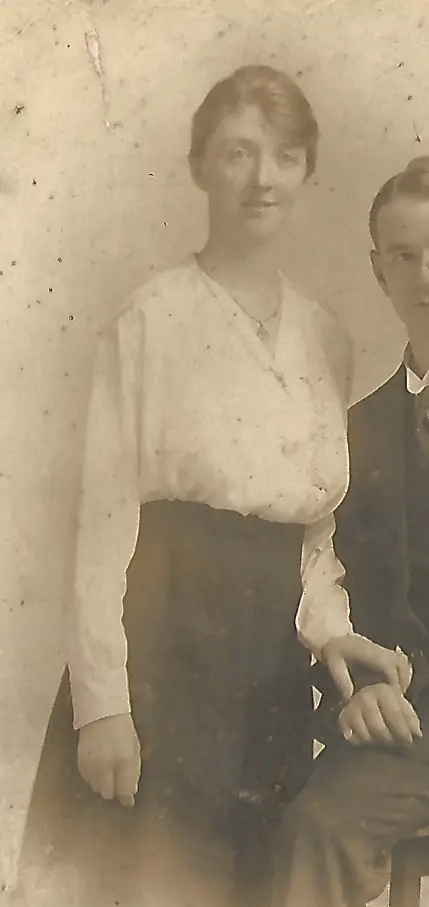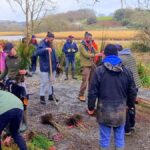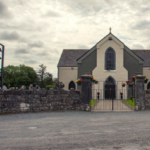By Gerry Quinn
GOING once, going twice, going gone.
On Wednesday afternoon, January 15, 1958, a crowd of between fifty and sixty people were gathered in an upstairs room of Carmody’s Hotel, Abbey Street, Ennis. The room was known as the Sarsfield Room, called after Patrick Sarsfield and was about 50 feet long and 30 feet wide.
They were attending the first of a three day auction of the contents of the old establishment that had closed its doors to business months earlier. Sometime after 2.30pm, Limerick based auctioneer Mr Louis De Courcy was about to take bids for segments of linen items, when the floor gave way in the centre, plunging the crowd into a room below. Eight people died and many were injured.
One of the eight fatalities was my maternal grandmother, Mrs Nora Considine of Corofin.
Forty years after the tragedy in 1998, I produced a radio documentary, ‘As If Night Fell’ to commemorate the event and it was first broadcast on Clare FM.
Concentrating on three views of the accident I interviewed a variety of people – relations and friends of the victims. Survivors of the crash and the townspeople of Ennis who recalled their personal recollections of the event, together with locals who got involved in the rescue attempts.
Later on that evening an air-crash at Shannon Airport claimed the life of pilot A.C. Morgan and amongst the cargo were photographs and film of the Carmody’s floor-collapse for the following morning’s newspapers.
Ennis was a much smaller town 60 years ago, with a population of less than six thousand. Everybody knew each other and Carmody’s crash had a profound effect on the citizens.
The old hotel that opened its doors for business in the first decade of the 19th century had provided lodgings for historical figures like Daniel O’Connell, Charles Stewart Parnell, The O’Gorman Mahon and Eamon De Valera. But in January 1958 it became notoriously associated with catastrophe and death.

Contemporary reports in The Clare Champion reflected vivid eyewitness accounts of the carnage.
Local Garda Sergeant Denis Hickey commented, “people were piled up in layers behind the door and that prevented us from opening through it. The place was black with dust,” he said.
One survivor recalled the moment of impact by saying, “there was no sound at first as the middle sank. Then there was a loud crash and everyone was thrown down. Bodies fell on top of each other and then there was terrific, screaming and shouting. Dust covered the whole place and things continued to fall for a minute or two. Then we were got out by the guards and others.”
Another who survived the accident told reporters, “we were all jammed together with furniture and rubble on top of us. The windows and doors had to be broken to get us out.”
The Irish Independent reported on its front page that, “the disaster occurred five minutes after the resumption of the auction following the lunch-break and utter confusion reigned before rescue work began and bodies were removed from what was described as a seething mass of humanity and debris, while the screams of the injured arose above all.”
There was also another fatality in Ennis that afternoon as the Independent reported. “Miss Lena McNamara 45 years old dressmaker Francis St., Ennis collapsed and died on her way to see her doctor a short time before the tragedy at Carmody’s Hotel. She was taken to the county hospital in the same ambulance conveying victims of the hotel tragedy and that at first gave rise to the rumour that nine people had been killed at the hotel accident.”
This inaccuracy was reflected in The London Times of January 16th. From Our Own Correspondent, Dublin Jan. 15, read the by-line. “Nine people were killed and 25 injured, some of them seriously, when part of the first floor of Carmody’s Hotel in Ennis, Co. Clare collapsed during a sale of furniture there this afternoon,” according to the report.
Sean Griffin, a 25 year old postal official who was standing outside the room at the time told The Times, “the auctioneer’s son had called him aside for a moment and as he walked away he heard a terrible tearing. He ran back and saw one end of the floor being pulled away from the wall. By that time some of the people on the upper floor had already been thrown into the room below. There was pandemonium as children, women and men screamed.”
The Times reporter also wrote, “other people who were present said that most of the rooms were filled with people viewing the furniture. They agreed that the floor went down gradually and that those in the centre of it had no chance to escape.”
Graphic details of an horrific vista still chillingly resound today.
Parents, grandparents, siblings and in one case, a 13 year old boy all perished on that fateful day, a black day for Ennis, a black day for Clare and for Ireland. In the interim since I produced ‘As If Night Fell’, 19 of the 28 interviewees for the documentary have passed away. I would sincerely like to remember and thank them and all those who contributed to the programme, for their honest and lucid accounts of that ill-fated day. Their memories and accounts of the accident have greatly contributed to the chronicling of events.
The eight victims of the 1958 Carmody’s Hotel Disaster were, Brigit Byrne (38) Kilrush, Josephine Carmody(50) Barefield, Margaret Coffee (41) Killoo, Clarecastle, Nora Considine (60) Corofin, Ernest De Regge (57), Bindon Street, Ennis, Thomas Donlon (13) Bindon Street, Ennis, James Fitzgibbon (65) Marian Avenue, Ennis, Helena McNamara (73) Crusheen.
On Sunday, January 14, as part of Carmody’s Hotel commemoration ceremony Clare Roots Society will launch their first book of 2018. Mayor Paul Murphy will launch the book at 12.30pm at the Parish Centre behind the Ennis Cathedral. It will be preceded by a Mass of Remembrance for the eight people who lost their lives on January 15, 1958.











